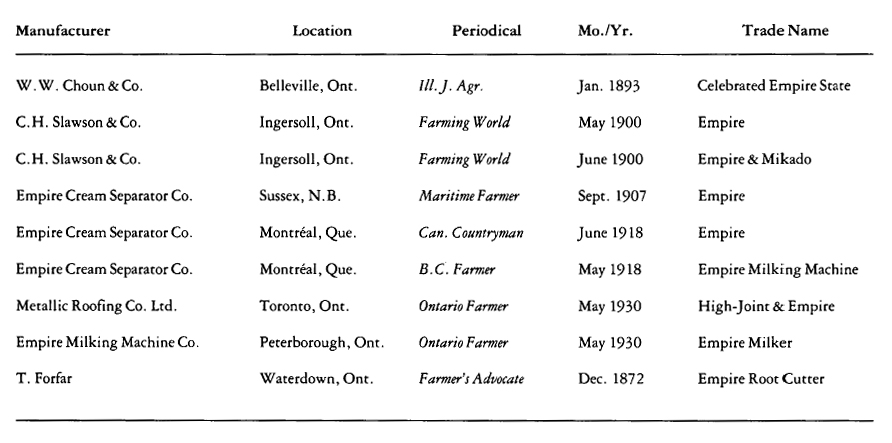Research Reports / Rapports de recherche
Canadian Agricultural Equipment Manufacturers Advertisement Index 1847-1942
1 To search through the bulk of information that our society processes in the form of books, magazines, tapes, and disks, we use indexes. For many searches, existing indexes are adequate. In searches for specific information about obsolete technical equipment, however, existing indexes frequently prove useless. The type of detail needed — dates of manufacture, points of distribution, trade names, and illustrations of certain items — can frequently be found in early technical periodicals. Some periodicals may list advertisers, but this is not very helpful if product information is sought. The ads are a good source of contemporary product information and are frequently accompanied by detailed representations of the product that seldom rely on the use of printers' stock illustrations.
2 Searching the ads on an item-by-item basis is tedious and time consuming. To make searching techniques more efficient and to minimize handling of fragile periodicals, the National Museum of Science and Technology decided to assemble an index of advertisements that could be consulted from several aspects, much like a cross-reference file. The specific subject field was agricultural equipment.
3 Canada has a rich heritage in agricultural-equipment manufacturing that began at the same time as the first ventures into clearing, cultivating, and cropping land, with farmers and blacksmiths producing handmade implements. The fabrication of agricultural equipment remained a local and individual manufacturing process until the mid-1800s. By that time techniques for manufacturing implement parts from cast iron had become practical and limited mass-production techniques were possible. Various manufacturers were soon able to cast virtually identical parts and to produce similar implements. The popularity of one machine over another came to be based on style, design, and proven efficiency as demonstrated in competitive trials. Advertisements that spread the fame of competition-winning implements were prominent in early agricultural periodicals.
4 Those with unique design features were patented to protect the manufacturer from copiers, and the announcement that a certain machine had such an exclusive feature was often part of the information in early ads. As successful designs became popular the demand for superior implements was filled by implement manufacturers who were well versed in the production techniques possible with the use of cast iron.
5 Implement manufacturers and implement foundries that stayed in business for many years were instrumental in preserving a history and a record of their own accomplishments through their trade literature as well as their products. Less-successful or less long-lasting manufacturers often did not leave much record of their endeavours, and the evidence of their existence remains in the implements they produced. These are often difficult to document because only part numbers, patent dates, or trade symbols cast into the iron parts remain as clues.
6 Information to assist in identifying implements can be found in ads in old technical periodicals. In the case of agricultural artifacts, farm papers such as The Farmer's Advocate and The Canada Farmer are a bountiful source of information.
7 Since implements frequently underwent redesign to improve their performance, detailed illustrations of implements in ads are very useful for identification and thus ads with illustrations are noted in the index.
8 Many implements were identified with trade names such as Champion, Lion, etc. Often these names or their associated symbols were cast or printed on the machine parts. Knowing the association between trade names and manufacturing companies is helpful in identifying equipment; therefore, the survey noted the trade names that appeared in the ads. Through the use of the index the trade names and symbols to company names can be linked.
9 Agricultural periodicals consulted for the index data are listed in this report. They include all Canadian agricultural periodicals identified by the author to date, the earliest appearing in 1847. The latest entry for 1942 marks what could be termed the beginning of the modern manufacturing era for agricultural equipment.
10 Summarizing the data collected revealed references for 2,012 Canadian entries in 544 locations for the time period 1847 to 1942. The index does not include all agricultural equipment manufacturers, possibly because some of them did not advertise in the periodicals. Certain errors and omissions in the original data have been identified; nevertheless, it is a useful tool for searching product information on agricultural equipment.
Organization of the Index
11 Data for the index were collected during the summer of 1982 and entered on the computer the following winter. To examine the index, contact the Library, National Museum of Science and Technology, 2380 Lancaster Road, Ottawa, K1A 0M8, (613) 991-2981.
12 Data collection involved examining all the agricultural periodicals available, on a page-by-page basis, and noting the required information on a specially designed form. In some cases, it was necessary to travel to the institution or library holding the periodical, while other periodicals were available on film.
13 The data collection form was developed and tested using material available in the NMST library. The index captures data for the following information groups: date, name of manufacturer, location, equipment, trade name, reference, illustration.
14 Information for each column presented unique problems which were resolved as the survey evolved.
15 Date — refers to the year in which the reference ad was published.
16 Name of Manufacturer — Where a manufacturer's name was prefixed by initials, for example, L.D. Sawyer and Co., the search was confusing. The use of a "containing" search — SAWYER — will alleviate this problem until correct entry of the data is completed. The same also applies in cases of mergers and incorporations.
17 Location — This refers to the location of the manufacturer. The problem that arises in recording this information resides in the multiple manufacturing or distribution locations and changes of centres of manufacturers shown in the ads. All locations were recorded.
18 Some confusion can arise from early reference locations that no longer exist because of name change, e.g., Berlin to Kitchener, or because of urbanization, e.g., Mimico to Toronto. In some cases, there is added confusion when two villages have the same name, e.g., Bondhead in Durham County and Bond Head in Simcoe County.
19 Equipment — There were two major problems in assembling data for this column. One problem was the identification of implements, tools, and apparatus that are agricultural and should be included. The other problem was deciding whether or not to develop and use a standard term for equipment that is commonly referred to by different names, e.g., threshing machine and separator. It was desirable to use the terms as they appeared in the ads rather than rely on the researcher to rename some of the items.
20 Archaic terms, such as "plaster spreader," which one would think of today as a fertilizer spreader, add to the confusion. As in the other situations, the decision was made to record an item with the name that appeared in the ad, assuming that those using the index would be sufficiently versed in the descriptive terms applied to agricultural equipment to know to search for the various names of implements, current or archaic.
21 Trade Name — Trade names and trade symbols are valuable tools in identifying equipment and relating product lines produced by various manufacturers; e.g., several manufacturers produced the Champion line of haying equipment in the early 1900s. To know that a piece of haying equipment was advertised as a Champion tells researchers that it has a certain form and it can be traced through another reference.
22 Frequently only a trade name or a symbol remains visible on an artifact. By linking the trade name or the symbol to an ad reference of a manufacturing company, an artifact can frequently be identified.
23 Reference — This identifies the location of the ad in the periodical by volume, number, month, and year, e.g. The Farmer's Advocate, vol. XLVII, no. 1028, June 6, 1912.
24 Illustration — Where the ad shows an illustration, the page number of the illustration is noted.
Examples of the Index's Use
25 When using the index to locate more information based on the identification clues on the artifact, one might enter a search knowing the location of manufacture, e.g., Grimsby. A search for manufacturers from Grimsby would reveal the following:
Hewson and Farrell
I.G. Pensyck
Rodolphns Lounsbury
W.W. Kitchen
William Mickson
26 Alternatively, one might begin a search for an "Empire" root cutter using the trade name. A search of the index would reveal the following companies that used the trade name "Empire."
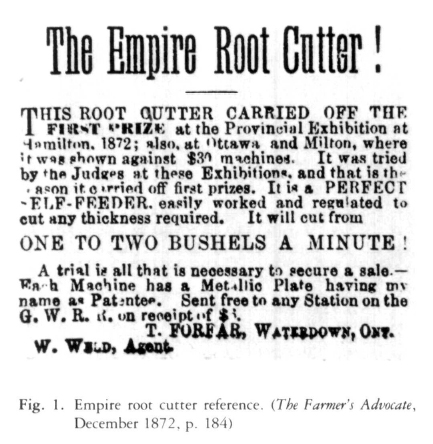 Display large image of Figure 2
Display large image of Figure 2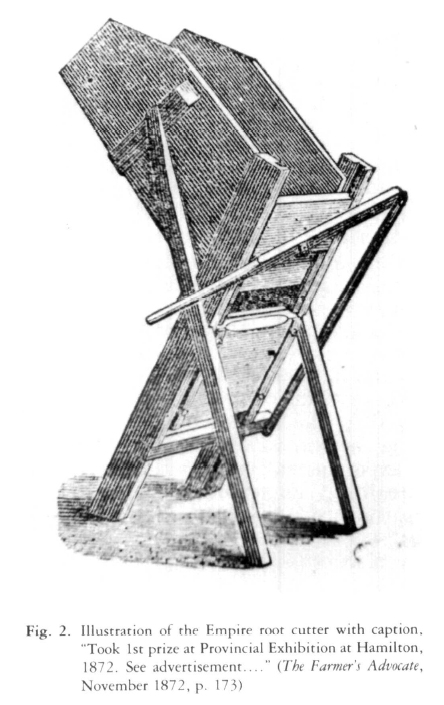 Display large image of Figure 3
Display large image of Figure 3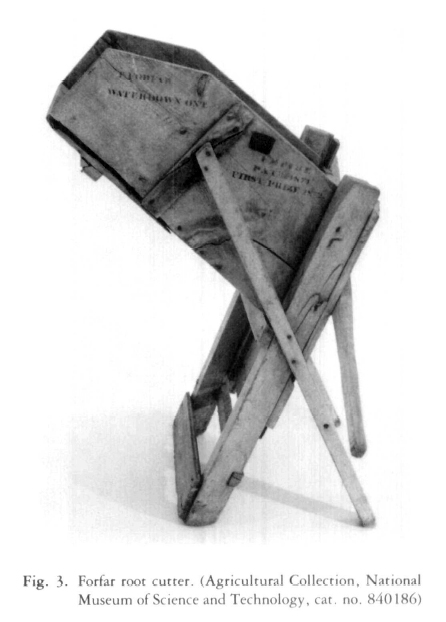 Display large image of Figure 4
Display large image of Figure 427 The reference to T. Forfar's Empire root cutter appeared as shown in figure 1. In the November issue (page 162) an editorial further discusses entries at the Provincial Exhibition:
This editorial comment and an illustration of the Empire root cutter on page 173 of the same issue (fig. 2) may have been the newspaper's way of encouraging a paid advertiser. There are many instances in The Farmer's Advocate that indicate there is a correlation between paid ads, editorial comment, and illustrated feature stories.
28 If one then compares the photo of a Forfar root cutter (fig. 3) with the 1872 illustration (fig. 2), another important source of product information becomes apparent. The illustration is good enough to be useful for identification and restoration detail.
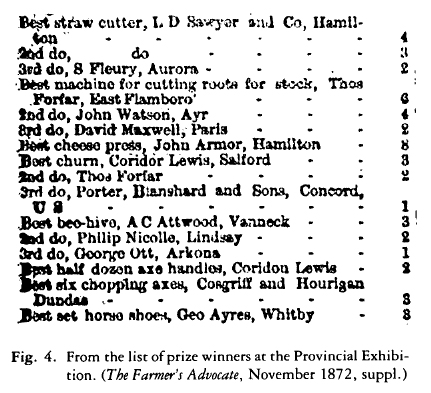 Display large image of Figure 5
Display large image of Figure 529 Further examination of the November issue of The Farmer's Advocate revealed more information about the Forfar Empire root cutter. In a supplement to this issue there was a list of prize winners at the Provincial Exhibition (fig. 4).
30 The index project is not regarded as being complete. Interested researchers are invited to contact NMST with names of Canadian agricultural periodicals not listed in the project.
31 The National Museum of Science and Technology is also developing an index of Canadian forestry-equipment manufacturers and suppliers. The status of the project will be reported in a future issue of the Bulletin.

